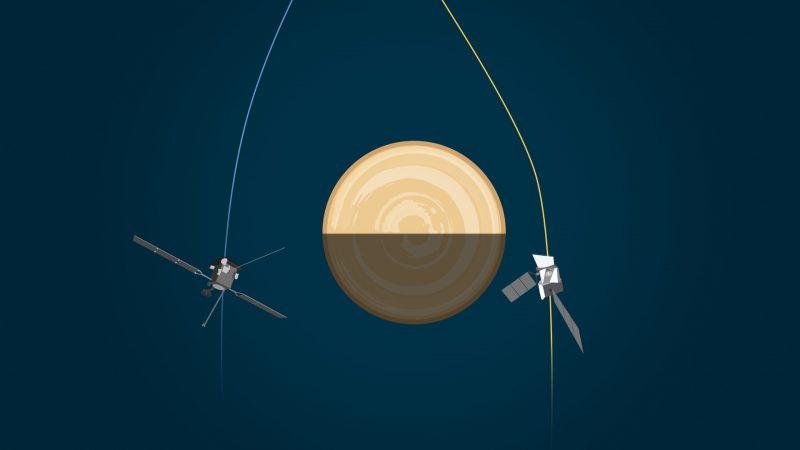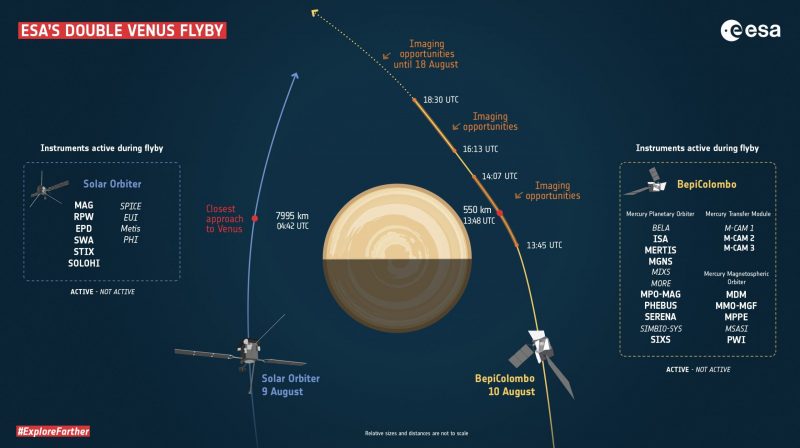How Long Will It Take To Get To Venus

Double Venus flyby
Venus is about to get a pair of visitors, within only 33 hours of each other. The two spacecraft both need gravity assists as they pass Venus. This is to lose some orbital energy on their way to their destinations: the sun and Mercury. The Solar Orbiter, a joint ESA and NASA venture, is heading toward the sun, where it will observe the solar poles. BepiColombo, a joint ESA and JAXA venture, is heading toward Mercury. The pair of spacecraft will zip past Venus on August 9 and 10, respectively. As they do, they'll turn their onboard instruments toward the cloudy planet.
First up, Solar Orbiter
Solar Orbiter makes its closest approach to Venus at a distance of 4,967 miles (7,995 km) on August 9 at 04:42 UTC (convert UTC to your time). Solar Orbiter passed Venus once already during a gravity assist in December 2020 and will make regular flybys of Venus as it increases its orbital inclination. As NASA's website says:
Solar Orbiter is traveling as close as 26 million miles [42 million km] from the sun, inside the orbit of Mercury, to measure the magnetic fields, waves, energetic particles and plasma escaping the sun while they are still in their pristine state, before being modified and mixed in their long journey from the sun.
The spacecraft must remain facing the sun during its flyby, but its SoloHI imager instrument on the spacecraft may be able to image Venus' nightside leading up to closest approach. Solar Orbiter will also collect data on Venus' magnetic and plasma environment.
Solar Orbiter will come back to Earth for a flyby on November 27 at a distance of 285 miles (460 km). Then the spacecraft will head back to Venus for more flybys, as it moves into its ideal observing position for the sun.
Next up, BepiColombo
BepiColombo makes its closest approach to Venus at a planet-buzzing distance of 341 miles (550 km) on August 10 at 13:48 UTC. BepiColombo launched in 2018 and is taking seven years to get to its target, Mercury. Its circuitous route will require flybys of Earth, Venus and Mercury itself to achieve Mercury orbit and battle against the gravitational pull of the sun. Once it arrives in Mercury orbit, the fun begins, as it tries to solve these five mysteries. According to ESA's website:
When it arrives at Mercury in late 2025, it will endure temperatures in excess of 350 C [662 F] and gather data during its one-year nominal mission, with a possible one-year extension … It will study and understand the composition, geophysics, atmosphere, magnetosphere and history of Mercury, the least explored planet in the inner solar system.
BepiColombo has already sent back images of Earth and Venus and soon will have more images to share. The spacecraft has three monitoring cameras that will focus on Venus during the flyby. The black-and-white pics should start arriving at Earth by the evening of August 10.
One thing the BepiColombo cameras won't see? Solar Orbiter. Nor will Solar Orbiter have a chance to take an image of BepiColombo. The two spacecraft remain 357,000 miles (575,000 km) apart at their closest approach.
Just like Solar Orbiter, BepiColombo will also gather information on Venus' magnetic and plasma environment. After leaving Venus, BepiColombo reaches Mercury on October 1 or 2, in the first of six flybys. The initial flyby drops it just 124 miles (200 km) above the planet's surface.

Animations of the 2 spacecraft flybys so close in time
Check out these animations of the Venus flybys. The first is of Solar Orbiter, on its second flyby of the planet, which will happen on August 9, 2021. The second is of BepiColombo as it makes a gravity assist past Venus on its way to Mercury. The BepiColombo flyby is on August 10, 2021.
Follow along on the 2 spacecraft flyby
You can follow the flybys live on social media. Follow @ESASolarOrbiter, @bepicolombo together with @ESA_Bepi, @ESA_MTM and @JAXA_MMO, and @Esaoperations for real-time updates. The public is invited to ask questions in advance using the hashtag #AskESA.
Bottom line: Two spacecraft, Solar Orbiter and BepiColombo, make flybys of Venus within only 33 hours of each other on August 9 and 10, 2021.
Via ESA
Kelly Kizer Whitt
View Articles
About the Author:
Kelly Kizer Whitt has been a science writer specializing in astronomy for more than two decades. She began her career at Astronomy Magazine, and she has made regular contributions to AstronomyToday and the Sierra Club, among other outlets. Her children's picture book, Solar System Forecast, was published in 2012. She has also written a young adult dystopian novel titled A Different Sky. When she is not reading or writing about astronomy and staring up at the stars, she enjoys traveling to the national parks, creating crossword puzzles, running, tennis, and paddleboarding. Kelly lives with her family in Wisconsin.
How Long Will It Take To Get To Venus
Source: https://earthsky.org/space/2-spacecraft-flyby-venus-solar-orbiter-bepicolombo/
Posted by: osbornedrel1998.blogspot.com

0 Response to "How Long Will It Take To Get To Venus"
Post a Comment